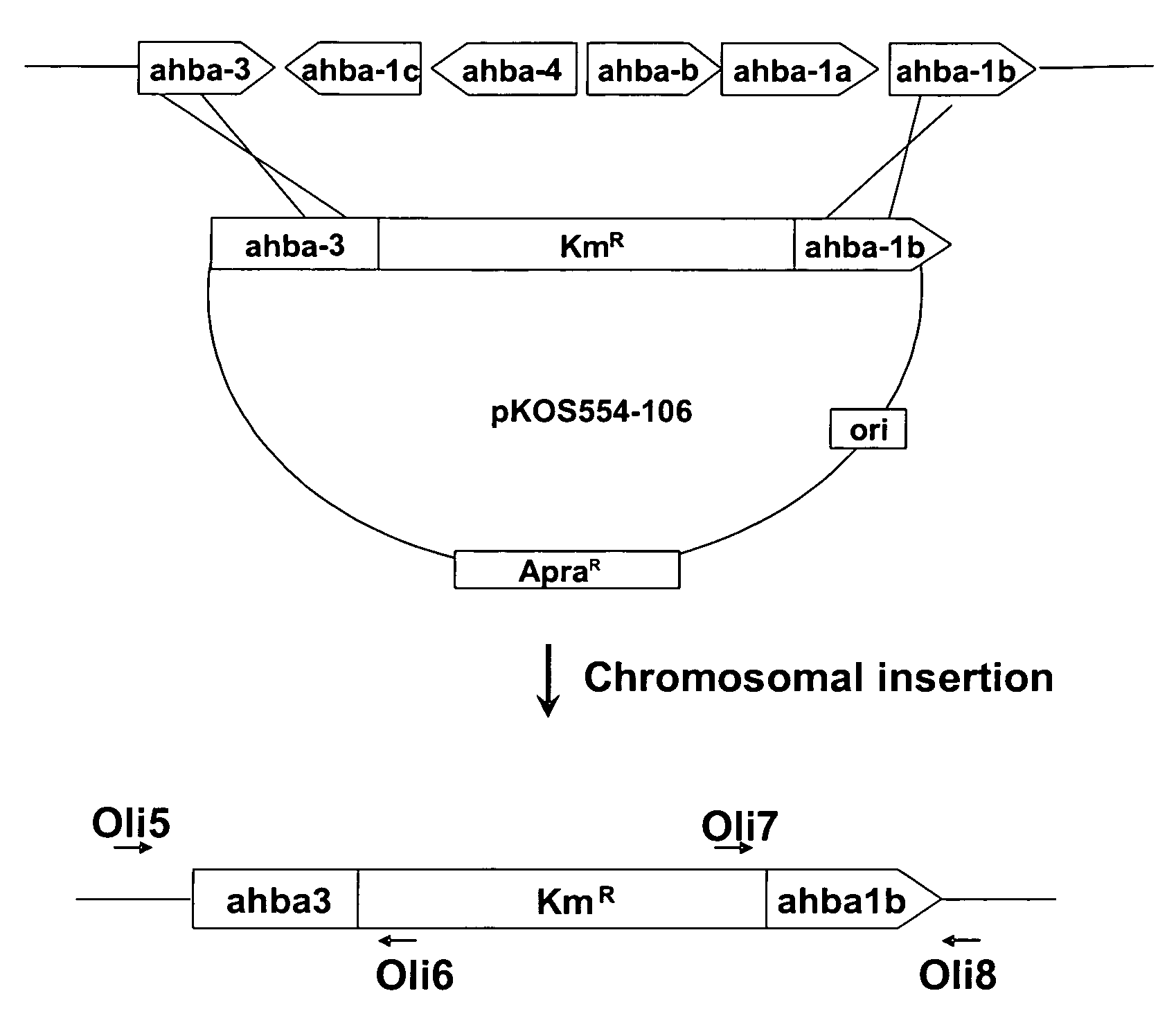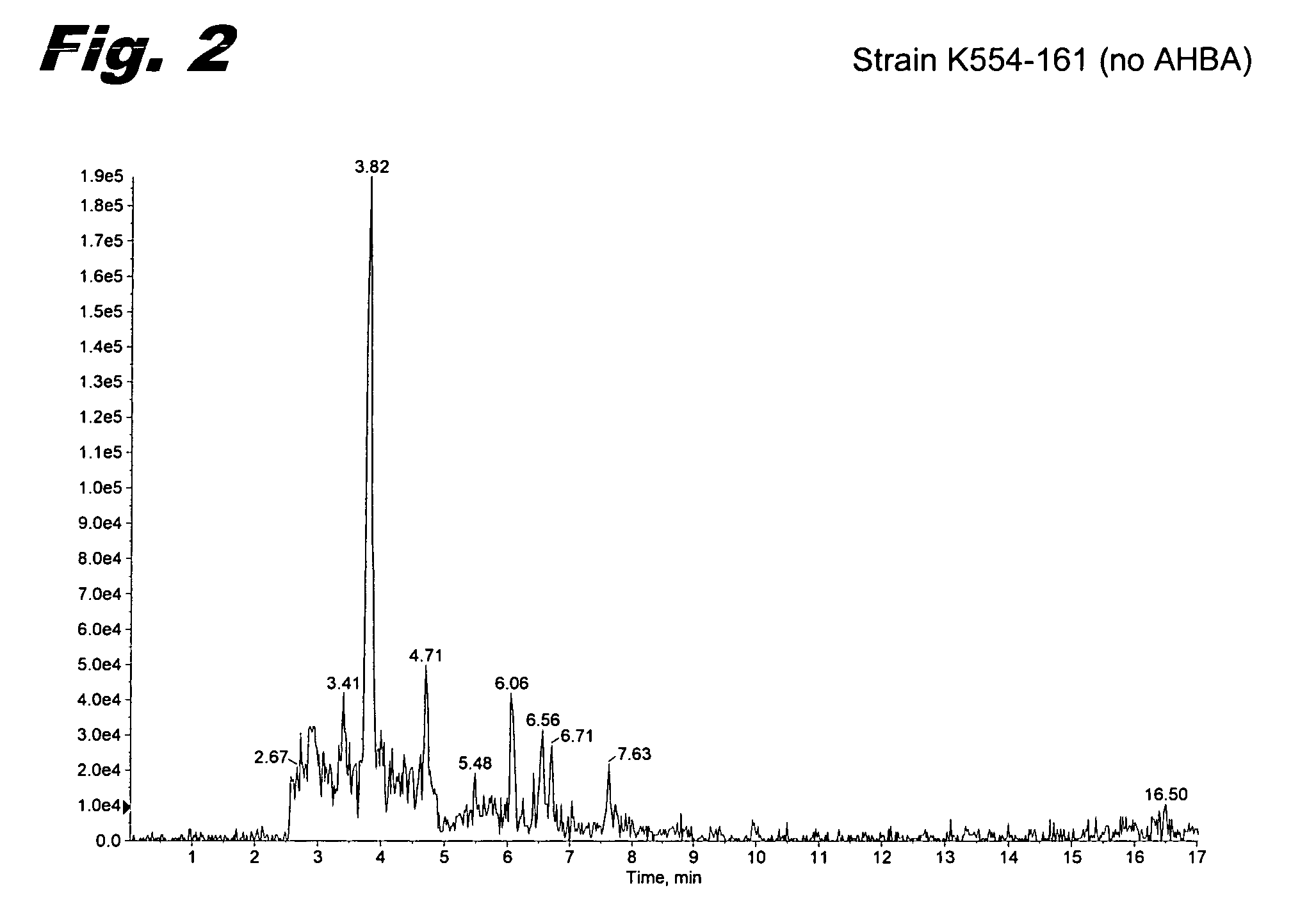Macrolactams by engineered biosynthesis
- Summary
- Abstract
- Description
- Claims
- Application Information
AI Technical Summary
Benefits of technology
Problems solved by technology
Method used
Image
Examples
example 1
Preparation of Strain K554-161
[0064]General. The ahba-b gene cluster of S. hygroscopicus NRRL 3602 is separated by more than 30 kb from the geldanamycin (gdm) PKS genes and contains six ORFs encoding the enzymes for the synthesis of AHBA (Rascher, supra). Two DNA fragments of ca. 1 kb at the border of the cluster were PCR amplified and used as homology arms to flank a kanamycin resistance cassette derived from pFDneoS. The construction was inserted into the conjugative plasmid pKC1139, which contains an apramycin resistance marker and a thermosensitive replicon.
[0065]Mutant clones where the disruption cassette was inserted into the chromosome were selected by incubating the cultures at the restrictive temperature. Next, 200 colonies were screened for the kanamycin resistant / apramycin sensitive phenotype, expected for the double crossovers. Genetic analysis by PCR of the selected colonies was used to identify a clone (strain K554-161) where the six ORFs of the ahba-b gene cluster had...
example 2
3-Amino-5-chlorobenzoic Acid
[0073]The hydrochloride salt of replacement starter unit 3-amino-5-chlorobenzoic acid was prepared as shown below:
[0074]3-Chloro-5-nitrobenzonitrile. Concentrated H2SO4 (440 mL) was added slowly to crushed ice (1200 g) and 2-amino-3-chloro-5-nitrobenzonitrile (43.8 g) was suspended in the resulting H2SO4 solution. After addition of 2-propanol (1600 mL), the mixture was heated to 40° C. internal temperature with vigorous stirring. A solution of NaNO2 (66.0 g) in water (100 mL) was added dropwise. After completion of addition, the mixture was kept at 40° C. for an additional 3 h, then cooled to ambient temperature and extracted with CH2Cl2. The organic extract was washed sequentially with water, 0.1 N NaOH, water, and brine, and then dried over MgSO4, filtered through a pad of silica gel, and evaporated to yield the crude product as a yellow solid. Chromatography on silica gel (20% EtOAc / hexanes) followed by crystallization from 2-propanol yielded the produ...
example 3
3-Amino-5-fluorobenzoic Acid
[0077]The hydrochloride salt of replacement starter unit 3-amino-5-fluorobenzoic acid was prepared as follows:
[0078]A mixture of 3-fluoro-5-nitrobenzoic acid (5.0 g) and 10% Pd / C (0.3 g) in MeOH (100 mL) and 6 N HCl (20 mL) was shaken under 30 psi H2 for 30 min. The catalyst was removed by filtration, and the solution was evaporated to dryness. The residue was crystallized from 6 N HCl to yield the product. 13C-NMR (D2O): δ 167.6, 162.5 (d, JCF=246 Hz), 133.8 (d, JCF=8 Hz), 132.6 (d, JCF=10 Hz), 119.7 (d, JCF=3 Hz), 116.7 (d, JCF=23 Hz), 115.2 (d, JCF=24 Hz).
PUM
| Property | Measurement | Unit |
|---|---|---|
| Structure | aaaaa | aaaaa |
| Strain point | aaaaa | aaaaa |
| Hyperproliferative | aaaaa | aaaaa |
Abstract
Description
Claims
Application Information
 Login to View More
Login to View More - R&D
- Intellectual Property
- Life Sciences
- Materials
- Tech Scout
- Unparalleled Data Quality
- Higher Quality Content
- 60% Fewer Hallucinations
Browse by: Latest US Patents, China's latest patents, Technical Efficacy Thesaurus, Application Domain, Technology Topic, Popular Technical Reports.
© 2025 PatSnap. All rights reserved.Legal|Privacy policy|Modern Slavery Act Transparency Statement|Sitemap|About US| Contact US: help@patsnap.com



